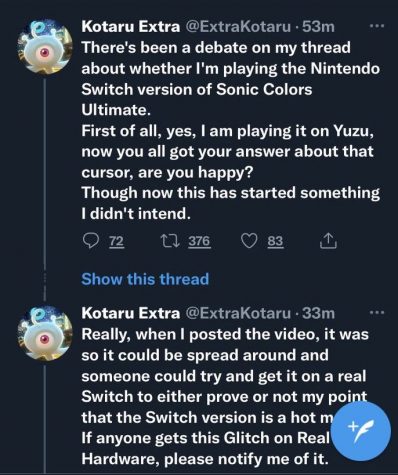Sonic Colors Ultimate Glitches: Real or Fake?
Sonic Colors Ultimate released on September 7, 2021. The game has been a very heated topic among video game players and fans of the franchise alike, all because of a glitch. Who would’ve known that the video of the glitch was faked?

A visual representation of the seizure-inducing glitch
October 6, 2021
How far would one person go to ruin the reputation of a fairly decent video game? While many would ask why they would do such a thing, others would not.
For months now, many people have been anticipating the new video game “Sonic Colors: Ultimate.” With it generating decent reviews before its official releases, and generally good promotional material, people were excited to see how the video game would be. That was, until the first day of the games release, on September 7, when a user on Twitter named Kotaro Extra tweeted a video focusing on a portion of “Sonic Colors: Ultimate” for the Switch being extremely glitchy, and could even possibly cause seizures. (See Image)

Everyone that anticipated this game became upset that this big of a glitch would go past the game developers and demanded a bug fix and patch. This eventually spiraled into a rabbit hole of people finding more and smaller glitches. People were finding more and more bugs on the game, specifically on the Switch.
Eventually, the official Sonic the Hedgehog social media manager spoke out on the matter, saying,”Quick aside: we’ve seen some graphical issues that were caused by an emulator which is unfortunately outside our control. Trying to figure out what bugs are legitimate can really slow down the QA process. If you’re having issues, please flag them here.” with a link to report bugs and glitches so the development team could fix them.
Many submissions were minor or major glitches, but the one they focused on was the one Kotaru had posted, as it turns out. This major bug that was achieved was put on an emulator, the Yuzu emulator, to be exact.
This was all discovered if people check Kotaru’s post history. It can clearly be shown that they were using an emulator. This eventually spiraled into a whole other situation, with many people trying to decipher if bugs/glitches were real or fake. Kotaru did end up actually apologizing, which can be found here, but discussions abound about how unnecessary it was to create a fake bug via an emulator.

This begs the question, why would people care so much for this game? For starters, Sonic the Hedgehog is a very popular and well-known video game franchise amongst video game players and dedicated fans alike. Many people seem to hate the franchise due to its bad reputation on the internet; however, if someone would take a deep dive in the franchise’s fanbase, it seems that there is more of a positive light to it, with many fan projects and fan art being produced for the franchise. This is why an extremely glitchy game would cause such an outburst.
This did eventually get resolved with SEGA officially coming out with a statement of looking into the bug, and fixing it regardless of an emulator. The company stated, “Hi everyone – We have deployed a patch for the Nintendo Switch for Sonic Colors: Ultimate. This is the first of several patches (for all platforms!) that will begin rolling out in the near future. Thank you for your patience!” which fixed many of the bugs present in the game that could potentially cause seizures.
Thankfully, this meant regardless of real or fake glitches, they found a way to fix it, which helped fans to simmer down a bit.
The fake bug that was made from Sonic Colors Ultimate still goes around, with many people claiming that the game is bad and showcasing the same video over and over again. This proves that one person posting a video of a fake glitch can ruin the reputation of one video game. Unfortunately, many people will not see this game as a good game anymore, even if the game is fixed up its main flaw.
This really shows how much the internet influences people’s views on things like video games: one person could easily make a video faking a glitch, and many people would think it’s authentic. When looking at video game media glitches, maybe try to take them with a grain of salt, and enjoy the game because a person personally likes it, not because everyone says so.

